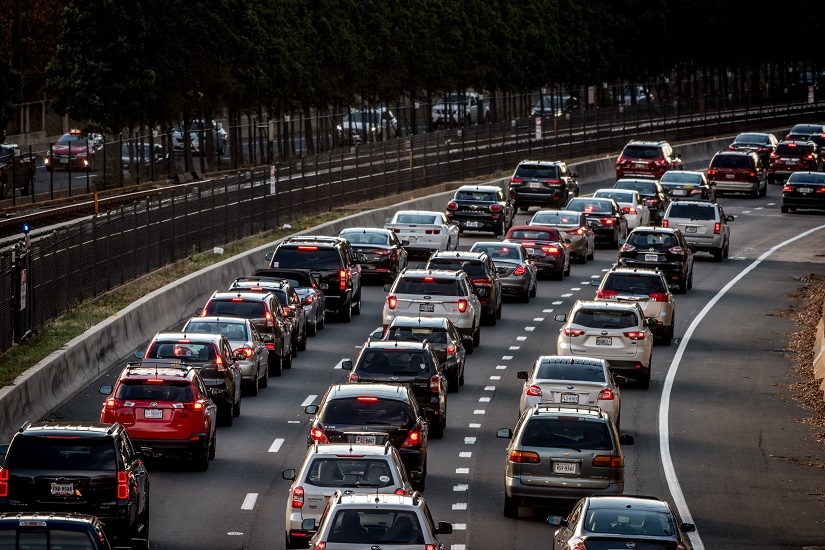The first phase of new construction on I-66 is in full swing. The lane widening project will add an additional travel lane on the eastbound side of the corridor and will span from the end of eastbound Route 267 (the Dulles Connector Road) to eastbound exit number 71 (Ballston). It will also add direct access to West Falls Church Metro for any multimodal commuters. While the construction will impact your commute with an end goal of increased commute efficiency, the addition of a lane further supports that commuters will need to make the most of the lanes through rideshare (carpool, vanpool) in order to move more people through the corridor.
We dig deep into the numbers to better understand how this project will accommodate more vehicles and reduce congestion.

Traffic Volume and Demand
The amount of time spent in traffic for the DC region is forecast to increase by 74% before the year 2040. Previous to the tolls, I-66 was struggling to cope with the demand and the number of cars that traveled through the corridor on a daily basis. While the new tolls are currently helping to mitigate congestion, the additional lane (ideally for HOV drivers) will help alleviate traffic as the region grows in the coming decades.
This highlights the need to educate travelers of HOV options, even with wider lanes, to maintain reduced congestion and to present commuters with a more efficient commute.
Seven Feeder Roads
The four-mile section of the interstate where the widening project will take place has several feeder roads. The following seven roads are identified below because of the high vehicle per hour demand and the origination points:
- I-495 and points south via the I-66/I-495 interchange
- I-66, west of I-495, from points west
- I-495 and points north via the Dulles Connector Road (Route 267)
- Washington Dulles International Airport and points west via the Dulles International Airport Access Highway and the Dulles Connector Road (Route 267)
- points west via the Dulles Greenway and the Dulles Connector Road (VA Route 267)
- Leesburg Pike (Route 7) and the Tysons and Vienna areas
- Dolley Madison Boulevard (Route 123) and the Tysons and McLean areas north via I-495
With these roads feeding into a section of I-66 where there are two general purpose lanes and an auxiliary lane, to accommodate the current demands, there will be another lane added to the interstate. This is done much to the relief of many commuters using the road during peak hours, but should be seen as an opportunity for all HOV drivers. According to the Transportation Research Board’s (TRB) 2010 Highway Capacity Manual, an additional traffic lane can carry approximately 20,000 vehicles per day. The addition of an extra lane would make it easier for HOV commuters during peak times to travel through this highly congested area.
The Outcomes
The average commute time on I-66, inside the Beltway, could be reduced with an additional general purpose lane with consistent HOV usage. Furthermore, the additional lane will eliminate 26,000-person hours a day. Finally, the additional lane increases the capacity of the corridor to serve more than 40,000 additional people a day.
Speed of traffic
The speed limit currently is set at 55 mph. With the current average speed on that stretch of I-66 at 57 mph due to the dynamic tolling system, the average speed would not likely increase. However, the average commute time could potentially decrease because of the extra capacity the new lane can accommodate.
New Noise Barriers
This summer VDOT will conclude its final noise analysis with the aim of replacing and building new noise barriers along I-66 on both the eastbound and westbound sides. During its public meeting in June, VDOT unveiled its plan to upgrade the noise barriers on both sides of I-66, build new concrete barriers to reduce noise pollution along the corridor, and replace existing barriers in state of disrepair. The project is expected to be completed by 2020.
Plan Your Commute
We know that new construction can disrupt your daily travel, but we’re here to help your employees or residents enjoy a stress-free commute. Find out what your transit options are and prepare for your commute ahead of time if you wish to avoid the dynamic tolls or construction projects on I-66. Download a custom Commute66 Quick Glance for Arlington, Alexandria, or Fairfax and find out what transit mode works best for you.
If your business or property requires a more customized Quick Glance for your employees or residents, contact Commute66 for more information.
Editor's Note: This post was updated by Maggie Awad to help clarify that an additional lane is an opportunity for HOV drivers and that the lane is added as a way to help the region through it's next growth cycle. This blog serves as an informative piece regarding the VDOT project and the impacts it will have on Arlington and the surrounding communities. We do not determine road construction and fully support the implementation of transportation demand management methods, including HOV options.
Photo Credit: Sam Kittner/Kittner.com for Arlington Transportation Partners

